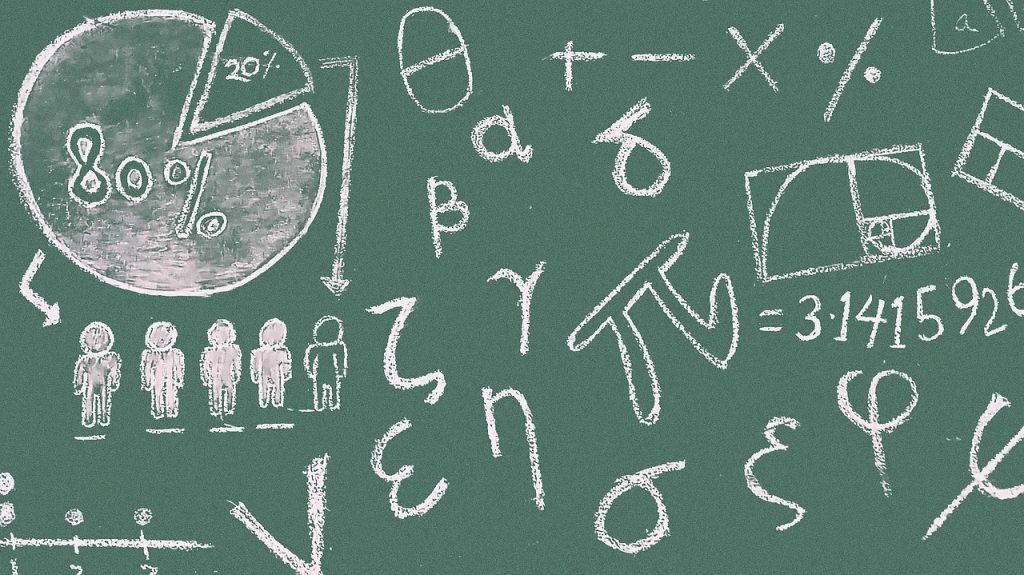
If you’re applying to business school, you’re probably going to have to take the GMAT, or the Graduate Management Admissions Test. Preparing for the GMAT requires a lot of time and effort, but you can’t create a successful study plan without knowing exactly what topics it tests you on.
So if you’re just beginning your GMAT prep, you’re probably wondering: what are the major GMAT subjects? What skills does the GMAT test, and what’s the basic format of the exam? What kinds of questions will I see? What topics should I be studying, and do I have to memorize anything? In short: what is on the GMAT?
Luckily, you’ve come to the right place! In this guide, we’ll break down exactly what you need to know for each section of the test, explain the different types of questions and skills they focus on, and then wrap up with some general tips on how to prep.
GMAT Subjects: What You Need to Know Overall
Each section is different, but what does the GMAT test you on as a whole? In a sentence, the GMAT tests your academic preparedness and readiness to succeed in MBA and other graduate business degree programs. It’s the most widely used test by both business schools and their applicants (read our guide to the GMAT versus the GRE for more), as it has proven to be a highly accurate metric for predicting how well someone will do in an MBA program.
Note that the GMAT tests your preparedness for business school: not your intelligence, and not whether you already have business skills and knowledge.
Not sure how or what to study? Confused by how to improve your score in the shortest time possible? We've created the only Online GMAT Prep Program that identifies your strengths and weaknesses, customizes a study plan, coaches you through lessons and quizzes, and adapts your study plan as you improve.
We believe PrepScholar GMAT is the best GMAT prep program available, especially if you find it hard to organize your study schedule and don't want to spend a ton of money on the other companies' one-size-fits-all study plans.

More specifically, the GMAT tests your analytical, writing, quantitative, verbal, and reading skills—in other words, what you’ve learned how to do throughout your academic career thus far.

Exam Format Basics: The 4 Sections of the GMAT
Now that you’ve gotten the broad strokes of GMAT subjects, let’s quickly go over the basic structure and the four different sections that you’ll see on the test. Then we’ll get into the exact subjects, question types, and skills for each section.
First, you should know that all four sections of the GMAT are timed, and all are taken consecutively on a computer at one of many testing locations around the world. In every section, you can only see one question at a time, and you cannot go back to re-answer or view previous questions: once you’ve answered and clicked “submit” for that question, it’s final.
The sections of the test are always in the same order, as laid out below:
The first section is the Analytical Writing Assignment. Here, you’ll get a short prompt that makes some kind of argument, and you’ll have 30 minutes to write a brief essay analyzing the given argument.
The second section is the Integrated Reasoning section. Here, you’ll get 30 minutes to complete 12 multi-part questions.
The third section is the Quantitative section. This is the big math section of the GMAT, and you’ll have 62 minutes to complete 31 multiple-choice questions, each with five different answer options. The Quantitative section is computer adaptive, meaning that the computer adjusts to your skill level as you go: starting from the very first question onward, subsequent questions are adjusted to an easier level if you answer incorrectly, or they are adjusted to a more difficult level if you answer correctly.
After Quant, you’ll hit the fourth and final section of the GMAT: the Verbal section. This is the big reading and grammar section of the test, and you’ll have 65 minutes to complete 36 multiple-choice questions, each with five different answer options. Like the Quant section, it is computer adaptive.
This information is distilled in the table below:
| GMAT Test Section | # of Questions | General Skill(s) | Timing |
| Analytical Writing Assessment | 1 prompt featuring an argument | Analysis of given argument | 30 minutes |
| Integrated Reasoning | 12 | Integrating information from different sources | 30 minutes |
| Quantitative | 31 | Math | 62 minutes |
| Verbal | 36 | Reading and writing | 65 minutes |
| Total Exam Time | 3 hours, 7 minutes |
Now that we know the basic structure and format of the GMAT, let’s dive right into what skills, subjects, topics, and question types are in each section.

What Is on the GMAT Analytical Writing Assessment?
The AWA is the “essay” portion of the GMAT; however, it likely differs greatly from most of the academic essays you’ve written thus far.
GMAT Topics and Skills Covered
According to the official GMAT website, the Analytical Writing Assessment (or AWA) measures “your ability to think critically and to communicate your ideas.” You will be given a single one-paragraph prompt containing some kind of argument. The prompts often center on debates from the business or political worlds and are sourced from the editorial and op-ed sections of magazines and newspapers, annual company reports, memorandums, proposals and beyond.
Question Types
You have only one task here: to write a critique of the given argument. The critique should contain an in-depth analysis of the underlying reasoning of the argument—including any flaws in reasoning that the author makes. Do not present your own views on the argument; stick to deconstructing the prompt.
The directions are always the same for the AWA. I’ve pasted them for you below:
Discuss how well reasoned you find this argument. In your discussion be sure to analyze the line of reasoning and the use of evidence in the argument. For example, you may need to consider what questionable assumptions underlie the thinking and what alternative explanations or counterexamples might weaken the conclusion. You can also discuss what sort of evidence would strengthen or refute the argument, what changes in the argument would make it more logically sound, and what, if anything, would help you better evaluate its conclusion.
Though a formal understanding of logic is not required, it’s helpful to be well-versed in persuasive writing and to understand concepts like counterargument and rebuttal, faulty reasoning, and claims and evidence.

What Is on the GMAT Integrated Reasoning Section?
The challenging Integrated Reasoning section tests multiple skills at once—hence the name Integrated Reasoning!
Want to improve your GMAT score by 60 points?
We have the industry's leading GMAT prep program. Built by Harvard, MIT, Stanford, and Wharton alumni and GMAT 99th percentile scorers, the program learns your strengths and weaknesses and customizes a curriculum so you get the most effective prep possible.

GMAT Topics and Skills Covered
According to the official GMAT website, the Integrated Reasoning (or IR) section measures “your ability to evaluate information presented in multiple formats from multiple sources—skills you need to succeed in our technologically advanced, data-driven world.” It’s a relatively new section that was added to the GMAT in 2012 as a way of better assessing the kinds of complex reasoning skills that you’ll need both in business school and in your career afterward.
Here is the official list of the four skills tested:
- Synthesizing information presented in graphics, text, and numbers
- Evaluating relevant information from different sources
- Organizing information to see relationships and to solve multiple, interrelated problems
- Combining and manipulating information from multiple sources to solve complex problems
Essentially, you will have to integrate data from different sources to solve complex, multi-step problems. The vast majority of the actual concepts tested in the Integrated Reasoning section are covered in the Quant and Verbal sections, which we get into below. The only additional concepts you’ll be tested on in IR are:
- The interpretation of different kinds of charts and graphs, and
- The basic functionality of column-sorting in spreadsheets.
In IR, unlike any other section of the GMAT, you have access to a very basic, click-operated calculator that is available on your screen. You probably won’t need to use it for every question, but it’s there for you when you do need it.

Question Types
The Integrated Reasoning section is a new and unique part of the GMAT; as such there are four very specific types of questions that you’ll encounter.
#1: Graphics Interpretation
In these questions, you’re given a graph or chart and some statements that pertain to it, and you have to select the option from one or more drop-down menus to make each statement accurate. It’s similar to a “fill in the blank” style question, but with drop-down menus limiting the number of options.
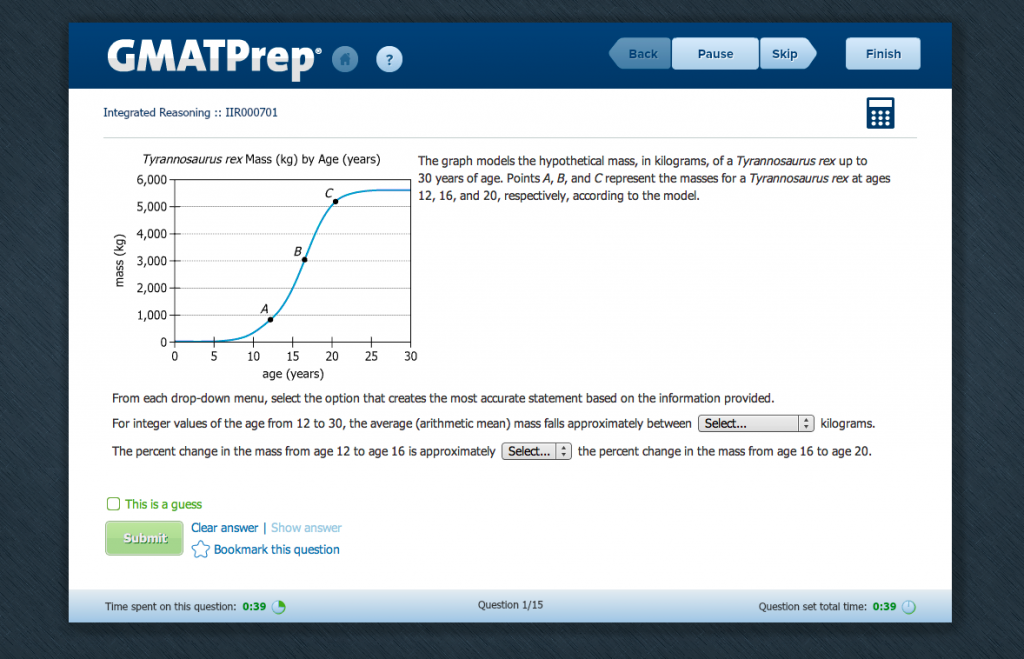
#2: Two-Part Analysis
Here, you’re given a paragraph of information and a two-column table that represents a two-part solution. Each column has a question and several answer options. You have to select one answer from each column to solve the problem.
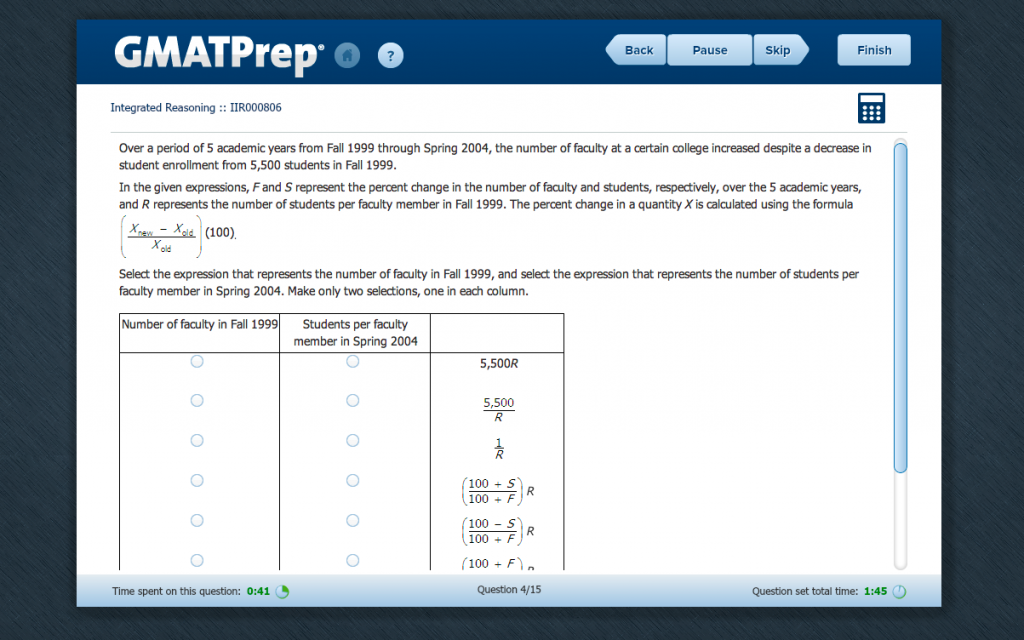
#3: Table Analysis
Here, you’re given a table of data that you can sort by data type, like in an Excel or Google Sheets spreadsheet. You have to organize the data to figure out whether certain conditions are met. Each question will have several statements with opposing answers (e.g., yes/no, true/false, inferable/not inferable) and you have to select one answer for each statement in the question.
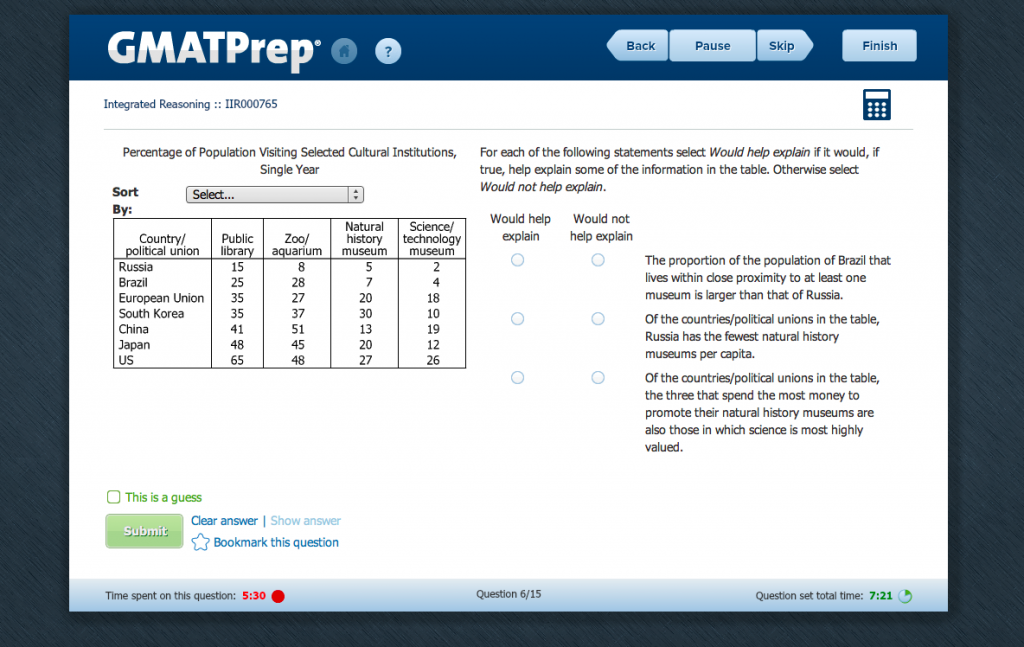
#4: Multi-Source Reasoning
These questions have a split-screen format. On the right side of the screen, you’re given multiple “tabs” that you can navigate among. Each tab contains different data—most often a few paragraphs of verbal information (with perhaps a chart). On the left side of the screen, multiple-choice questions are presented one by one, and you have to figure out what information from which tabs you need to answer each question.
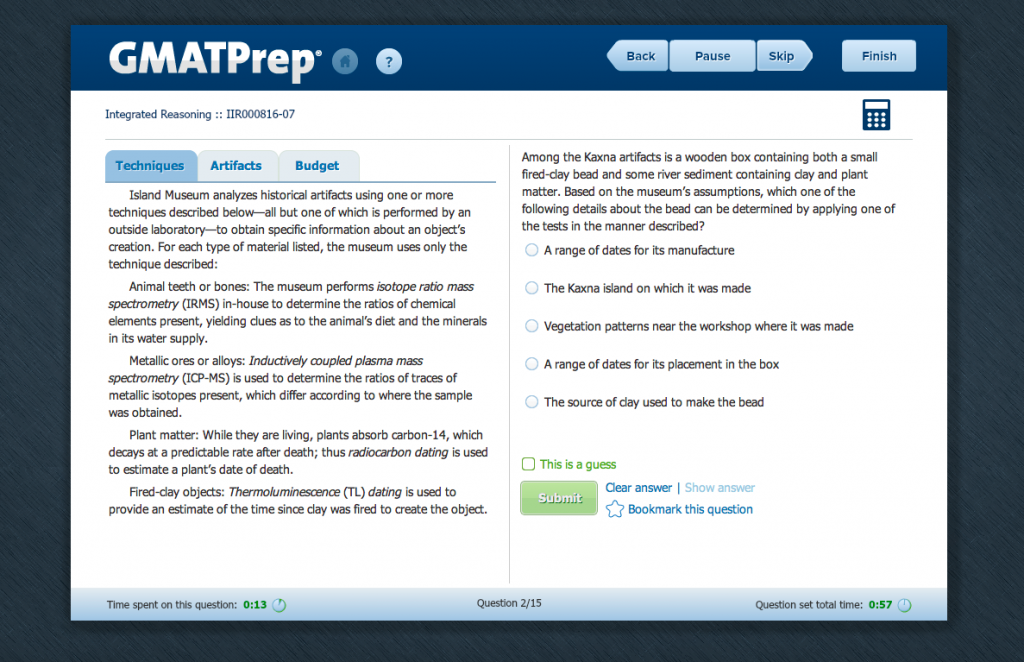
An important note: even though most Integrated Reasoning questions have more than one part to them, there is no partial credit given. You have to answer all parts of a single question correctly to receive credit. If, for example, you correctly answered one “true/false” statement on a table analysis question but missed another statement, you would not receive any credit for the question.
What Is on the GMAT Quant Section?
The Quant section is the main math section of the GMAT, and marks the start of the multiple-choice portion of the exam.
GMAT Topics and Skills Covered
According to the official GMAT site, the Quantitative (or Quant) section measures “your ability to analyze data and draw conclusions using reasoning skills.” The actual math subjects tested are all from what you learned in middle and high school math: algebra, arithmetic, geometry, and word problems within these three areas. You don’t need trigonometry and you certainly don’t need calculus.
Want to Identify YOUR GMAT Strengths and Weaknesses?
Our proprietary GMAT Diagnostic Assessment creates a customized study plan for you that takes you from registration all the way to test day! It is included with every account and proven to significantly maximize your score.
Get your personalized assessment as part of your 5 day risk-free trial now:

Here are all the math topics that are covered in the Quant section, organized by subject area:
Arithmetic
- Properties of Integers
- Fractions
- Decimals
- Real Numbers
- Ratio & Proportions
- Percents
- Powers & Roots of Numbers
- Descriptive Statistics
- Sets
- Counting Methods
- Discrete Probability
Algebra
- Simplifying Algebraic Expressions
- Equations
- Solving Linear Equations with One Unknown
- Solving Linear Equations with Two Unknowns
- Solving Equations by Factoring
- Solving Quadratic Equations
- Exponents
- Inequalities
- Absolute Value
- Functions
Geometry
- Lines
- Intersecting Lines and Angles
- Perpendicular Lines
- Parallel Lines
- Polygons (Convex)
- Triangles
- Quadrilaterals
- Circles
- Rectangular Solids and Cylinders
- Coordinate Geometry
Word Problems
- Rate Problems
- Work Problems
- Mixture Problems
- Interest Problems
- Discount
- Profit
- Sets
- Geometry Problems
- Measurement Problems
- Data Interpretation

Question Types
There are two types of questions on the Quant section: problem solving questions and data sufficiency questions.
Note that there is not a fixed number of questions in either category—it varies from GMAT to GMAT. You’ll also never tackle all of one and then all of another: they are interspersed with each other randomly throughout. With that said, let’s dive into what you’ll see in each type.
Problem Solving
Each problem solving question gives you a problem followed by five multiple-choice answer options, and you have to work to solve the problem and pick the correct answer from among the options.
Data Sufficiency
Each data sufficiency questions consists of a question followed by two statements, labeled 1 and 2. Your task is to determine whether the information provided in either each statement alone or the two statements together is sufficient (or enough) to answer the question.
This is also then followed by five multiple-choice answer options; however, unlike in problem solving questions, the five answer options for data sufficiency questions are always exactly the same. We have copied them below:
(A) Statement (1) ALONE is sufficient, but statement (2) alone is not sufficient.
(B) Statement (2) ALONE is sufficient, but statement (1) alone is not sufficient.
(C) BOTH statements TOGETHER are sufficient, but NEITHER statement ALONE is sufficient.
(D) EACH statement ALONE is sufficient.
(E) Statements (1) and (2) TOGETHER are NOT sufficient.
What Is on the GMAT Verbal Section?
If the Quant section can be described as the main math section of the GMAT, the Verbal can be described as the main reading and writing section.
GMAT Topics and Skills Covered
According to the official GMAT site, the Verbal section measures “your ability to read and understand written material, to evaluate arguments, and to correct written material to conform to standard written English.” You’ll have to identify logical relationships between ideas and concepts, summarize and paraphrase passages, draw inferences, point out flaws in assumption and reasoning, and correct improper grammar or syntax.

Question Types
There are three different kinds of question types on the Verbal section: reading comprehension, critical reasoning, and sentence correction.
Reading Comprehension
The reading comprehension portion of the GMAT consists of four short (250-350 word) passages, each with three to four questions associated with it. They are sourced from textbooks, journals, periodicals, scholarly articles, and the like, centering on topics from the natural and social sciences, the humanities, and the business world. Note that no outside knowledge is expected in any of these domains—all of the information you will need to answer the questions is in the passages themselves.
There are several different kinds of reading comprehension questions:
- Main idea: asks you to accurately summarize the main idea or main purpose of the passage.
- Supporting ideas: asks you about supporting details, facts, or descriptions.
- Inferences: asks you about what is implied but not explicitly stated in the passage.
- Analyze logic and organization: asks you about how the passage is constructed; how the author persuades the reader; to identify underlying assumptions, strengths and weaknesses of the argument; or to point out potential counterarguments.
- Apply info from passage to a context outside of passage: asks you to identify hypotheticals, similar examples, or if the author would agree with a given statement.
- Style and tone: asks you to deduce the author’s attitude toward a specific idea or describe the overall tone of the passage.
Occasionally, you may encounter a question asking you to identify quant concepts as presented in writing in the passages, but the quant concepts that appear on such questions are fairly simple compared to what you see on the Quant section itself.
Critical Reasoning
Critical reasoning questions measure the reasoning skills you use when forming arguments, evaluating arguments, and forming or evaluating a plan of action. As with reading comprehension, you are given a passage drawn from a variety of subject areas and sources, and you are not expected to have any prior knowledge of any of them. The passages will always be making some kind of argument, and the questions you encounter will test how well you understand this argument. The three sub-categories these questions fall into are:
- Argument construction: asks you to recognize basic structure, conclusions, assumptions, well-supported hypotheses, or parallel situations.
- Argument evaluation: asks you to analyze reasoning and methodology, point out errors, or identify what would strengthen or weaken the argument.
- Form/evaluate a plan of action: asks you to compare the effectiveness of different plans of action, identify what would strengthen or weaken success of a plan of action, or discern assumptions underlying a plan of action
As with the AWA, you don’t need to know the rules or terminology of formal logic to answer these kinds of questions, but it helps to be well-versed in the tactics of persuasive writing.
Sentence Correction
Sentence correction questions test your proficiency in the English language—namely your ability to correct a given sentence to make it clear, concise, and grammatically correct.
In these questions, you’re given a sentence, part or all of which is underlined. You have five multiple-choice answer options for re-phrasing the underlined portion, and you must pick the answer that makes for the best sentence.
The broad categories of grammar and syntax rules that the GMAT tests are:
- Agreement (noun-verb and pronoun-antecedent)
- Diction (standards/conventions and commonly misused words—EG, “among” versus “between”)
- Sentence construction (independent and dependent clauses; phrases; what counts as a noun/subject and what counts as a verb/predicate; conjunctions; fragments and run-ons; punctuation)
- Idioms (prepositions, correlatives, and forms of comparison)
- Modifiers (dangling and misplaced)
- Verb tenses and moods
- Verbals (noun and adjective uses of verbs)
Command over grammar is the most vital skill to have for sentence correction questions, but grammar is still just one part of what you’re being tested on: you will encounter sentences that are grammatically correct but are still awkward or redundant and need to be reworded for more clarity and concision.
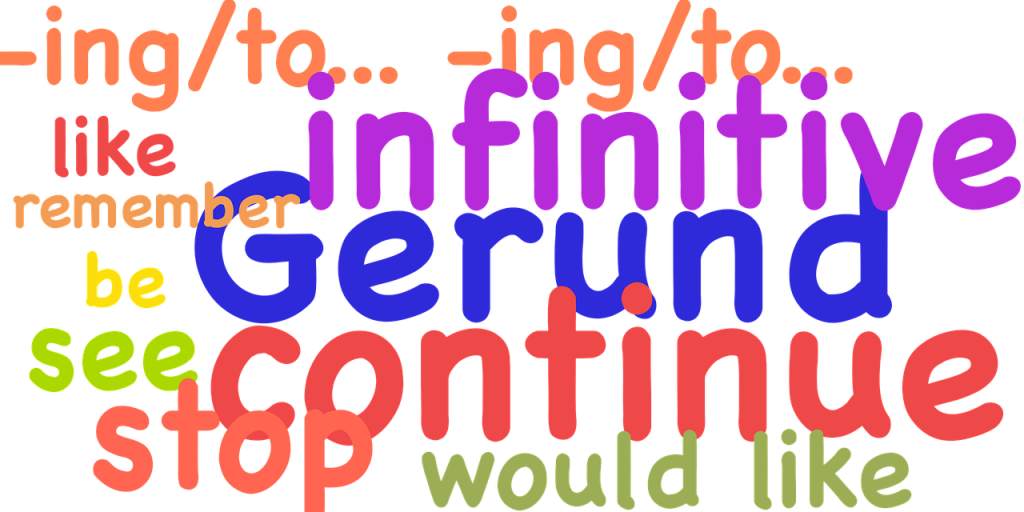
4 Tips for Key GMAT Subjects to Study
Now that we’ve gone over the topics and question formats covered on the GMAT, let’s dive into the key subjects to study for each section.
Study Persuasive Writing for the Analytical Writing Assessment
As stated above, though a formal understanding of logic is not required for the AWA, you can see that it’s important to be well-versed in persuasive writing and to understand concepts like counterargument and rebuttal, faulty reasoning, and claims and evidence.
Here’s a useful one-pager on Toulmin Analysis to get you started. Toulmin Analysis is a great academic entry point into basic tenets of creating and rebutting an argument, particularly if you’re unfamiliar with foundational terms like “counterargument” and “rebuttal.” You should also read mba.com’s sample top-scoring AWA essay and list of real AWA prompts to familiarize yourself with the kinds of arguments presented and the responses that will score highly.
Study Graphs and Charts for Integrated Reasoning
When you study for the GMAT Quant and Verbal sections, you’re already learning the basic academic knowledge needed for IR section. In addition to those subjects, you should make sure to study up on the fundamentals of graphs and charts, tables, and spreadsheets so that you’re not surprised by any data presentation format on the test.

Memorize the Fundamental Rules, Values, and Properties for Quant
The key to mastering Quant is to memorize the key equation rules, values, properties and shortcut within the subject areas listed in the Quant subsection above, because you’ll need to do quick mental math and you will not have access to a calculator.
Above all, the absolute most important math topics to know inside and out are:
- Number properties (especially the properties of integers)
- Factors and multiples
- Fractions, decimals and ratios
- Statistics
- Properties of sets
- Percentages
- Rates
- Exponents and powers
- Geometric properties of basic shapes and coordinate geometry
- Systems of equations/isolating and solving for a variable
- Inequalities
Read and Memorize GMAT Grammar Rules for Verbal
The most important method for studying for the Verbal is to read. While there is no outside knowledge expected in any of the key subject areas that you’ll see on the Verbal section, you should get in the habit of reading one article a day from the kinds of magazines and periodicals from which they source arguments and passages. This strategy has a variety of benefits, including familiarizing yourself with the subjects, increasing your critical reading skills, and honing your intuitive grasp of grammar and syntax. Some great sources we recommend to get you started are National Geographic, The Economist, and Scientific American.
For sentence correction questions, the grammar rules that you’ll be tested on are a bit particular, so you should just go ahead and memorize them. Here is a comprehensive PDF of all of the grammar you’ll need to know for the GMAT for exactly that purpose (coming soon).
What’s Next?
The next step is to learn how each section on the GMAT is scored to complete your foundational knowledge of the exam. If you still have questions about GMAT subjects or other fundamentals of the test, check out our guides to what the GMAT actually is, how hard it is, and how much time you should budget to prepare for it too.
Unsure which test to take for business school? We can help you compare and contrast the GMAT with the GRE as well.
Happy studying!
 PrepScholar GMAT
PrepScholar GMAT